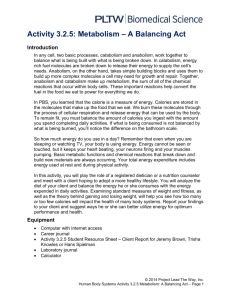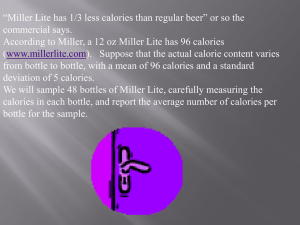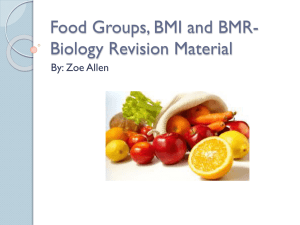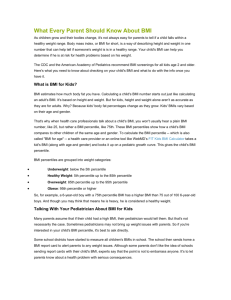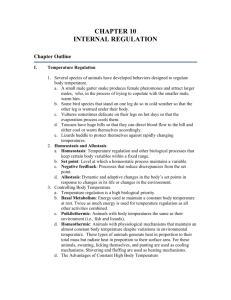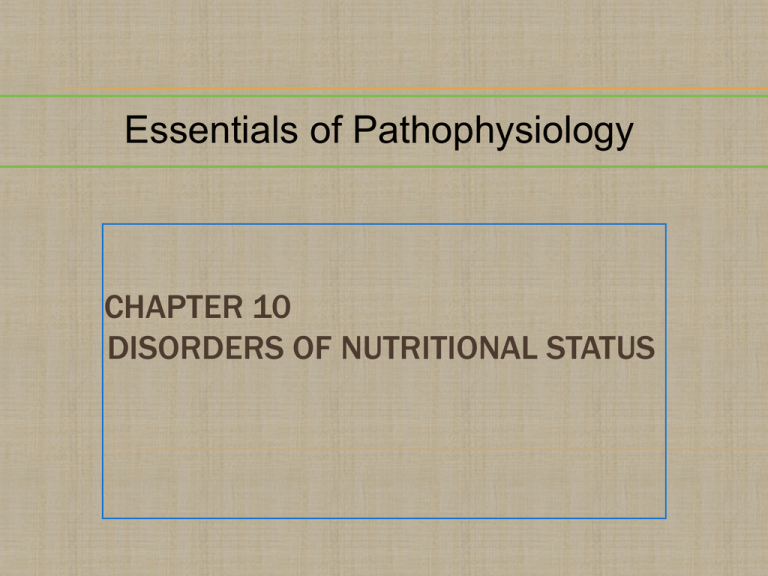
Essentials of Pathophysiology
CHAPTER 10
DISORDERS OF NUTRITIONAL STATUS
PRE LECTURE QUIZ (TRUE/FALSE)
F
F
F
F
T
The incidence of childhood obesity has
remained stable over the last 10 years.
More then 90% of body energy is stored in the
skeletal tissues of the body.
Energy requirements are decreased during
growth periods.
Both anorexia nervosa and bulimia nervosa
involve weight fluctuations that may drop to
dangerously low levels.
Vitamins A, D, E, and K are known as fatsoluble vitamins.
PRE LECTURE QUIZ
circumference
Height
Marasmus
Obesity
Recommended
The ______________ Dietary Allowances (RDAs)
define the average daily intakes that meet the
nutrient needs of almost all healthy persons in
a specific age and sex group.
The body mass index (BMI) uses ____________
and weight to determine healthy weight.
______________ is defined as a condition
characterized by excess body fat.
Waist ______________ is used to determine the
distribution of body fat.
_______________, a condition of malnutrition,
represents a progressive loss of muscle mass
and fat stores owing to inadequate food intake
that is equally deficient in calories and protein.
CALORIES IN = CALORIES USED + CALORIES STORED
Caloric intake is controlled by appetite
Hunger and satiety centers in hypothalamus
Calorie use is controlled by metabolic rate - Set by:
Thyroid hormones and
Activity levels Exercise, physical activity, etc.
Calories are stored in
adipose tissue
White adipose tissue
Brown adipose tissue
QUESTION
Tell whether the following statement is true or
false.
A calorie measures the energy used to break
down nutrients.
ANSWER
False
Rationale: A calorie is simply energy measured in
heat units (the amount of heat or energy
required to raise the temperature of 1 g of
water 1° Celsius). Metabolism is the
breakdown of nutrients.
SCENARIO:
You just ate a big dinner.
Question:
How did you know when to stop eating?
How do you know you are still full?
What will make you feel hungry again?
SHORT-TERM REGULATION
Food detected
by GI tract
oral receptors
detect tasting,
chewing,
swallowing
GI tract
secretes
hormones
insulin
glucagon-like
peptide-1
cholecystokinin
hypothalamus
satiety center
feeling of
“fullness”
stomach
stretches
INTERMEDIATE AND LONG-TERM REGULATION
EAT excess
calories
Feeling of
Well Being
Decreasess
increased
blood
glucose
adipose
cells
release
hormones
leptin
Feeling
of Well
Being
Stresses
of Life
hypothalamus
satiety center
feeling of
“fullness”
increased
blood
ketoacids
INTERMEDIATE AND LONG-TERM REGULATION
Hypothalamus
(-)
Leptin
(+) Hunger
Center
Neuropeptide
Y
(-)
Adipose
cells
release
leptin
Triglycerides
(-)
Stresses
of Life
EAT excess
calories
Feeling
of Well
Being
(+)
QUESTION
What part of the brain controls both hunger and
the feeling of fullness?
a. Cerebral cortex
b. Hypothalamus
c. Reticular formation
d. Thalamus
e. b and d
ANSWER
b. Hypothalamus
Rationale: The feeding center for hunger and
satiety is contained in the hypothalamus. The
hypothalamus takes in information from the GI
tract, blood, and cerebral cortex in order to
determine when to begin eating and when to
stop.
ASSESSING NUTRITIONAL STATUS
Body weight
Relative weight = actual weight/desirable weight
Body mass index = weight (kg)/height (in meters)2
1M= 39.4 in
1 kg = 2.2 lb
Percentage of body fat
LBS 1 KG
BMI
2.2 LBS
IN 1M 2
(
)
39.4 IN
CALCULATE YOUR BODY MASS INDEX (BMI)
If your BMI >= 25 Overweight
If your BMI>= 30 Obese
If your BMI>= 40
Morbidly Obese
Weight in Pounds
200
=
2.2
72
39.4
Height in inches
2
=
Weight in Pounds
90.9
=
2.2
27.2
3.3
Height in inches
39.4 then square it
Divide this by
this and put it
here this is
your BMI
UPPER VS. LOWER BODY OBESITY
Courtesy of Ahmed Kissebah, M.D., Ph.D., Medical College of Wisconsin, Milwaukee
CLINICAL MANIFESTATIONS OF OBESITY
QUESTION
Tell whether the following statement is true or
false.
A BMI that is greater than normal increases an
individual’s risk of developing type 2 diabetes
mellitus.
ANSWER
True
Rationale: Normal BMI = 18.5 – 24.9. BMI >25
places individuals at increased risk for type 2
diabetes, cardiovascular disease, and
hypertension. The higher the BMI is above
normal, the greater the risk of health problems.
MALNUTRITION
Marasmus [muh-raz-muhs]
Too few calories in diet and
Too little protein in diet
Kwashiorkor (kwah-shee-awr-kawr)
Adequate calories in diet but
Too little protein in diet
CLINICAL MANIFESTATIONS OF KWASHIORKOR
Adequate
Calories but a
lack of protein
CLINICAL MANIFESTATIONS OF MARASAMUS
Basic Starvation lack
of protein and Calories
PROTEIN-CALORIE MALNUTRITION
Question:
Based on your knowledge of organ functions, what might
happen if protein production decreases in the:
Liver
GI tract
Heart
Diaphragm
EATING DISORDERS
Anorexia nervosa
Bulimia nervosa
Binge eating
Question:
Which would be the least serious? Why?
Which would be the most serious? Why?






